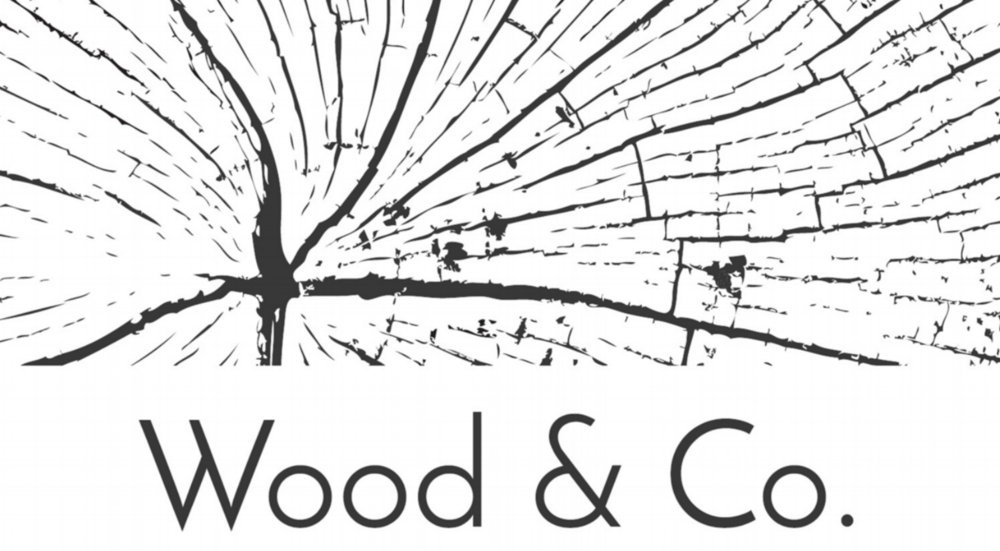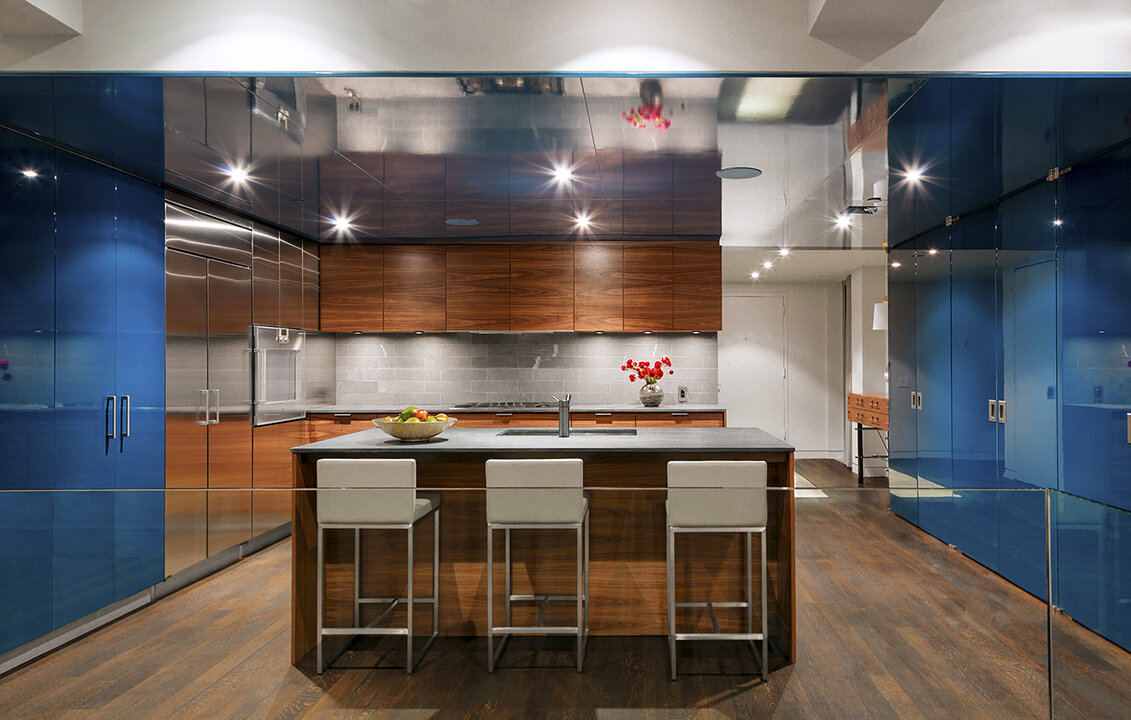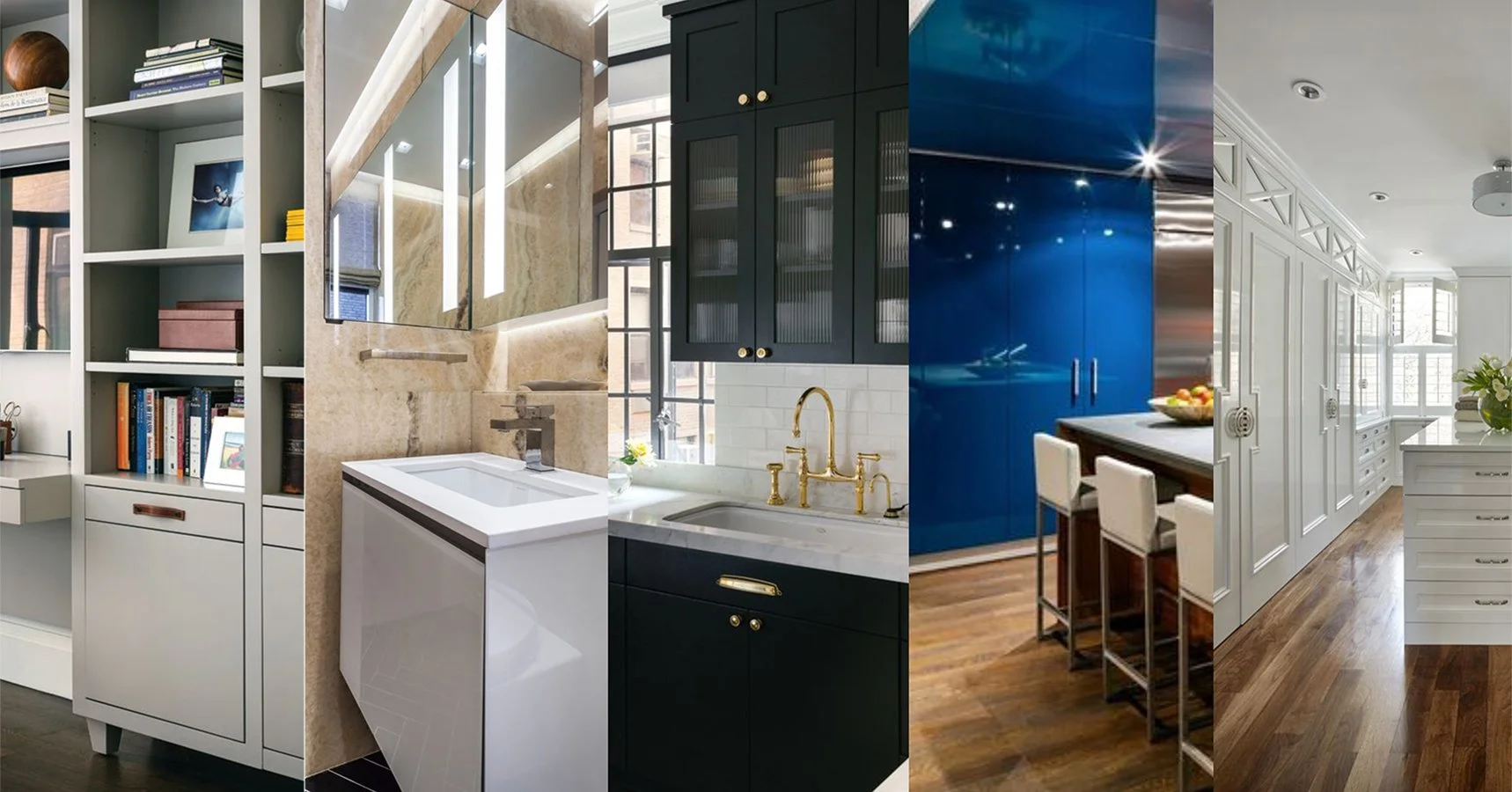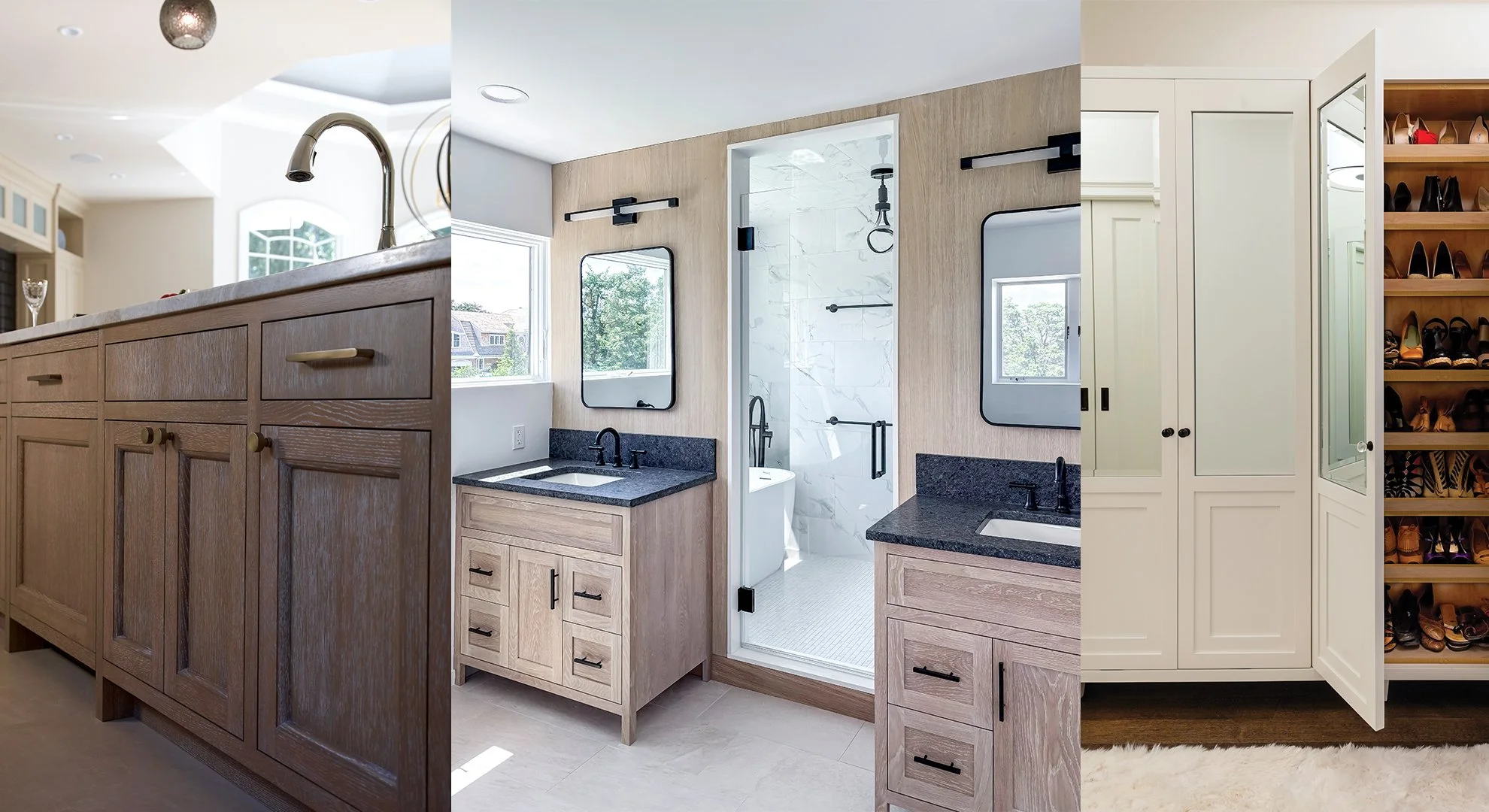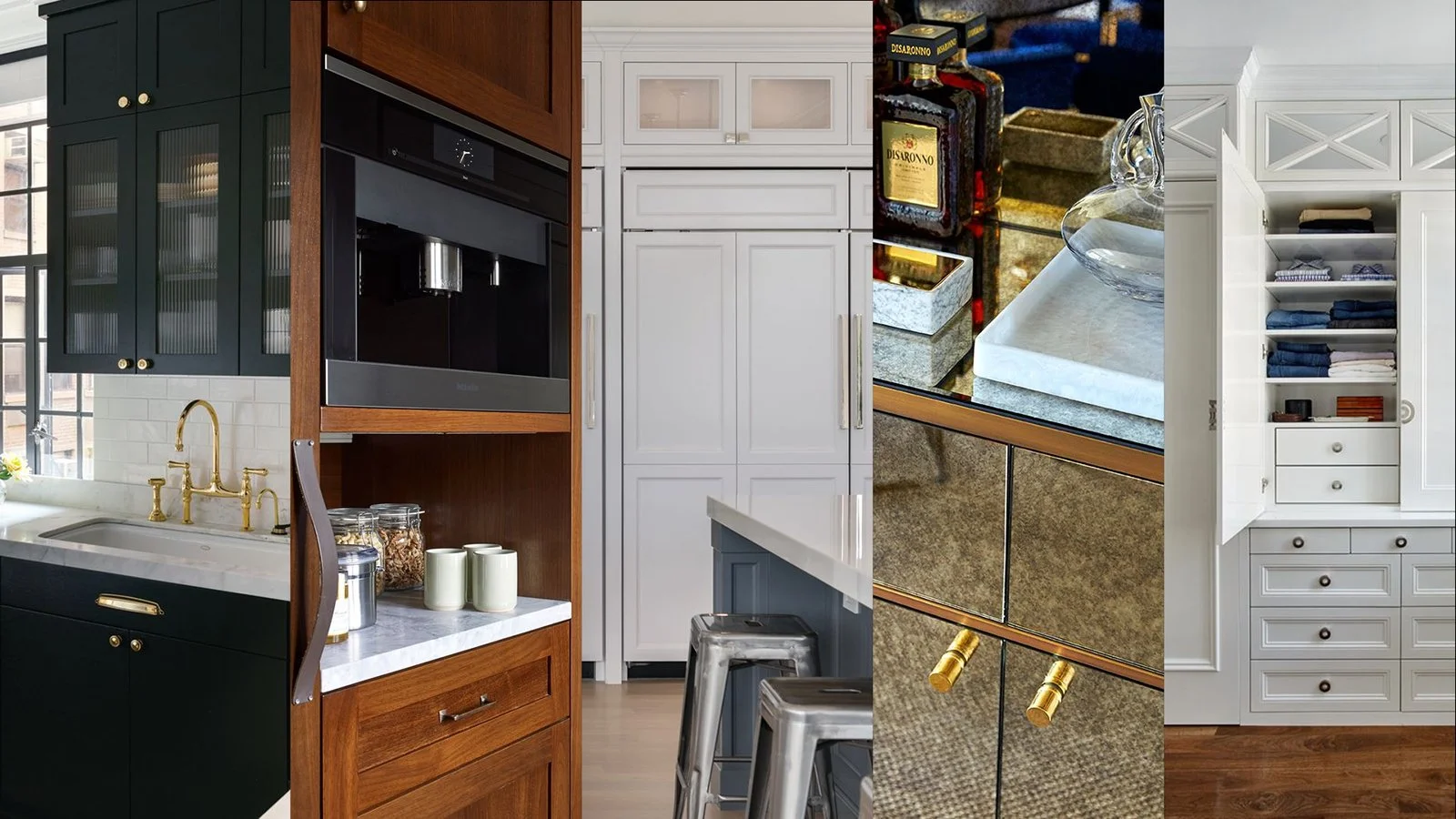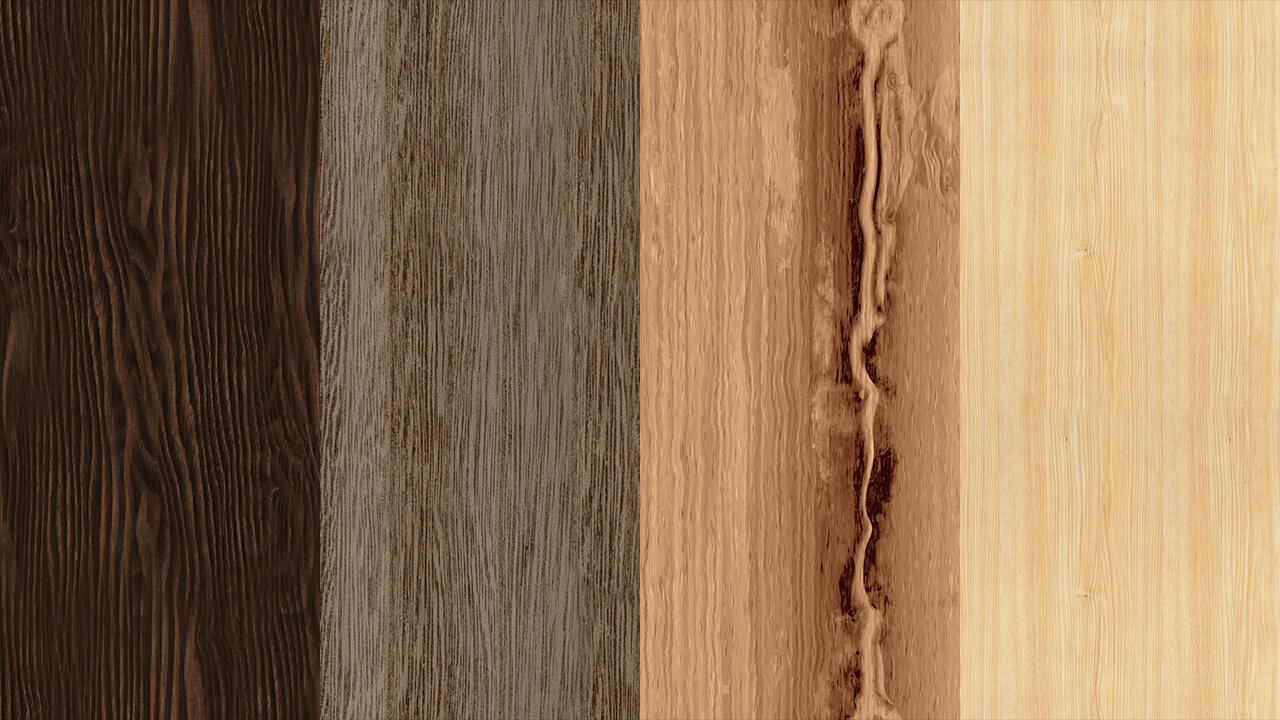And we are back with part 2 of our Ultimate Guide to Designing a Kitchen! In the previous part, we focused on the more general aspects of your kitchen: identifying your needs, laying out the space, and choosing a design style. These will be our guideposts, so to speak, as we iron out more details in part 2.
Now we’re going to turn our focus towards a major component of any kitchen: the cabinetry.
If you’re looking for the other parts, click on these below:
Kitchen Cabinets
By this point, you likely have a clearer image of how your kitchen works, how you’ll move about the space, and how it will look. But we’re not done yet! It’s time to examine one of the most prominent aspects of your soon-to-be new kitchen: the cabinets.
Types of Cabinet Materials
There are many types of materials that your cabinets can be made of. Which one you choose will determine factors such as costs, durability, and reparability.
Hardwood or Solid Wood
Hardwood undoubtedly the first material many homeowners think of when envisioning their dream kitchen. There are plenty of options such as white oak, walnut, hickory, and pine to name a few. Each one of them has their own unique grain pattern, coloring, and distinct look. This means that each cabinet face and each drawer front will have its own individual character when you use hardwood.
Another advantage to using hardwood for your kitchen is its durability and ease of repair. Even if you get it scratched or stained, it can easily weather common repairs such as sanding and refinishing. This ensures that you can keep your cabinets looking good for many years with proper care and regular maintenance.
There are some disadvantages too, of course. In general, hardwood will be more expensive than the other materials below. It’s also important to know that hardwoods are heavy –really heavy. If you’re planning to use full height or very tall upper cabinets, then you need to make sure that your home’s structure can support it.Plywood
Plywood is another common material used in kitchen cabinetry –and for good reason. It’s a highly versatile and durable material. Because of its strength, flexibility, and resistance to moisture, it’s often used for the cabinet sides, backs, and shelves. It holds nails and screws well, and it even works for glued joinery. It’s easy to see why it’s the most preferred material for cabinet boxes.
It’s not used as much for door fronts, however. But even that’s beginning to change in recent years. Designers have started bringing plywood to the forefront –quite literally. This material brings a characteristic “raw” look and feel, perfect for many design styles, such as the ever popular Scandinavian kitchen design.Its main drawback is still its price. It’s slightly less expensive than solid wood, but definitely much pricier than the materials below. Secondly, because of how it’s constructed, some plywood may come with holes or gaps, needing for more meticulous inspection before using them.
Particleboard
Particleboard is an engineered material made by bonding together recycled wood products, such as wood chips and sawmill shavings. It’s one of the most inexpensive options for cabinets at around 10 to 20% cheaper than plywood. Because it’s made of scrap material, it’s also very eco-friendly.
Unfortunately, particleboard cabinets come with a lot of downsides. It’s not moisture-resistant at all, a poor fit for wet areas like a kitchen. Moisture will discolor the board and make it swell. In general, it does not hold up well, with a tendency to sag if too much weight is placed on it. Also because of its low density construction, it does not hold nails and screws well, and can be damaged easily while in transit.While a commonly offered material, it’s best to avoid particleboard if you can afford to do so. However, they do have their place in situations where you want to keep costs down as much as possible, such as rental properties and short-term residences.
Medium Density Fiberboard (MDF)
Medium Density Fiberboard, or MDF for short, is another engineered material commonly used in cabinets. It’s especially common in stock cabinet options and affordable furniture. If you’ve ever seen or used an IKEA cabinet, then you’ve probably seen an MDF cabinet. It’s made of fine wood fibers that are bonded together under high pressure. This makes it more durable than particleboard, but not quite as strong as plywood. MDF panels are often used in conjunction with laminates or wood veneers. This can give an appearance close to that of real wood, but without the hefty price tag.
Even if it can get close to the look for solid wood, that’s where the similarities end. It still can’t match natural wood when it comes to handling loads and withstanding stresses. It cannot be sanded down, making it difficult to repair dents and scratches. Its fibrous construction also means that it does not hold nails and screws very well, making it even less durable than plywood or hardwood. Lastly, it can be difficult to handle. It’s relatively heavy, while also having little impact resistance. Extra care must be taken when dealing with medium density fiberboards.
Kitchen featuring a mix of high gloss painted finish, stained walnut finish, and stainless steel finish by Wood & Co.
Types of Cabinet Finishes
Painted Finish
A painted finish is one of the most basic, but also most versatile finishes possible for a cabinet. While white painted cabinets are the most common one you’ll see, your options are endless with so many colors to choose from. This lets you have creative freedom and works well with just about any design style.
The problem with painted cabinets is that they can easily show signs of wear. Frequently used areas are more prone to scratches and chips. Definitely something to consider for a busy area like the kitchen. You may end up having to repaint or refinish your cabinets more often than you’d like.
Stained Finish
A wood stain is a product applied on the wood that’s used to add color and protect it. However, there are also natural stains available, letting you show off your wood’s innate color if you so choose. It comes in various types such as oil-based, water-based, and gel-based –each with their own pros and cons.
Choosing a stained cabinet finish is often done when you want to enhance or highlight the natural texture of wood grains. This can add a warm, cozy, and earthy atmosphere in your kitchen. Stains can vary from lightly colored ones to dark and moody ones, making it a versatile option for any home. Generally, stained cabinets are low-maintenance. Small dents and scratches are not as obvious as they blend in with the wood grain.
Lacquer Finish
Lacquer is a type of topcoat finish most used for highly glossy finish, although it’s also available in a matte variety. It’s the clearest topcoat you can use, letting you fully appreciate the wood or color underneath. It’s also easy to work with and very forgiving of application mistakes. You can easily sand away a mistake and reapply it. The new coat and the prior coat underneath blends together perfectly.
However, while it’s generally resistant to damage and impervious to most household liquids, it does have some drawbacks. Over an extended period of time, lacquer finishes are prone to discoloration. It dries quickly, so it’s best applied via spray, which makes it a bit unfriendly for DIY work. The use of a sprayer also means you need a large and well-ventilated workspace to finish the cabinets.Wood Veneer
A wood veneer is a very thin slice of wood, so thin that it can even be less than 1/40 of an inch thick. These slices are then applied onto a core such as plywood, MDF, or particleboard. This type of finish is most often used as an alternative to solid wood. Because it’s still taken from natural wood, a wood veneer still retains the desired natural look of solid wood. Applying it onto a plywood core can make it more durable than solid wood, while applying it to MDF or particleboard can greatly reduce cost. An added benefit to wood veneer is its eco-friendliness. Because wood is cut into thin slices, the yield for decorative surface area is higher compared to a solid wood board. It can also be more versatile than solid wood for some situations, such as on curved surfaces.
Laminate
In many ways, a laminate is similar to a wood veneer, except it’s made with synthetic materials –usually tough papers or plastic. It’s not real wood, but it can be made to look close to it. But it also comes in a variety of other looks such as solid colors, stone-like, or patterned. You find this finish most often in office furniture. Laminate finishes are easy to clean and maintain, making it great for areas that see a lot of wear. Because of its wide selection of colors and ability to mimic the look of just about any material, it’s easy to fit into any design style. It’s also budget-friendly because it’s easy to manufacture.
A downside to laminate lies in it being a synthetic surface. It cannot mimic the natural variations in wood grain or the subtlety of marble striations. Additionally, because it’s pressed onto a core, laminates will start to lift over time. And once it’s damaged, laminate cabinets are hard to repair, often needing replacement.
Types of Cabinet Hardware and Accessories
Cabinet pulls, handles, and knobs are the jewels on your cabinetry. They come in a wide selection of colors, finishes, and profiles that can really bring together your kitchen. Ornate pieces with a polished finish can work well in a more traditional style. A simple brushed nickel round bar door handle, on the other hand, will fit easily in a transitional or contemporary style.
When it comes to choosing whether to go for handles or knobs and what size to choose, consider ergonomics. A long cabinet pull is much easier to grip than a tiny knob. However, since they’re larger, they make more of a visual statement and can make your cabinets look busy. Of course, there’s nothing stopping you from using both cabinet pulls and cabinet knobs! A common approach is to use pulls for drawers and knobs for cabinet doors.
Integrated Pulls
If you want to maintain the sleek and streamlined look, then consider using integrated pulls instead. Routed finger pulls and continuous aluminum profiles are some of the most common iterations you’ll see. For some people, these can be difficult to use, especially if you have larger fingers. It’s also hard to get a good grasp of a drawer, which can be an issue if it’s been stuffed with heavier items.
Hinges
While often an unassuming piece of hardware, hinges are an integral part of your kitchen cabinetry. You can have them either concealed or exposed. Kitchens leaning more on a traditional or period-specific style frequently expose the hinges’ barrels. Some hinges like a T-style hinge features more ornate wings that are visible on outside. On the opposite end of the spectrum, contemporary styles often call for concealed hinges to preserve the cabinetry’s streamlined exterior.
Hinges can come with additional features that can add a level of convenience to your cabinets. Self-closing hinges, as the name implies, automatically closes your cabinet doors for you –often just needing a light tap. Soft-closing hinges are similar, but their main purpose is to prevent the cabinet door from slamming. It catches the door at the last moment and then slowly closes it. Some hinges also feature a limited swing or a wide angle swing, which can be useful depending on how your cabinets are configured.
Drawer Slides
When not using hinges, you’re likely making use of drawer slides. There are many types to choose from. Ball-bearing drawer slides are the most common type, which uses steel ball bearings on a track to allow your drawers to move smoothly. If you don’t want your slides to be seen whenever you pull out the drawer, then you can opt for centermount or undermount drawer slides instead.
Another factor to consider when you’re picking slides is how far they extend out from your cabinet front. The most common one is the ¾ extension slide. Your drawer only partially opens, meaning the rear of the drawer box often becomes inaccessible. However, these are the most affordable option. If you want full access, look towards full extension drawer slides or over-travel drawer slides. Because they pull out further, you essentially create a longer lever arm. This makes full extension drawers weaker, so be sure to check the allowable load.
This brings us another crucial consideration when selecting drawer slides: the load rating. This tells you how much weight you can place in your drawers. If you load them beyond what they’re rated for, you run the risk of breaking your drawer slides. When in doubt, it’s better to err on the side of caution and either put less items in your drawer or specify a heavier duty drawer slide.
Pull-outs, Roll-outs, and Other Storage
This broad category is the next step up after your basic hinges and drawer slides. They’re highly functional hardware that can help you maximize your space and eke out even more storage space from your kitchen.
Pull-outs come in many types, sizes, and functions. Pull-out trash bins are a great way to keep your trash and recycling in close proximity without being an eyesore. A spice pull-out is a great way to keep your little bottles of herbs and spices organized without taking up a ton of space. On the other end of the size spectrum, you have fully featured pantry pull-outs. These allow you to have complete access to all your food, bottles, jars, and whatever else you put in there. Unlike just using regular cabinets with shelves, you save yourself the trouble of reaching in and digging out items you need.
Kitchen islands by Wood & Co. with dark stone waterfall edge countertops.
Kitchen Countertops
Tall cabinets aside, all your kitchen base cabinets are likely going to have a countertop on it. But just like with the cabinet body, there’s also plenty of things to consider. As you’ll soon find out, there’s more to it than just picking out a nice type of stone!
Light vs. Dark Countertops
Even among the same type of stone or wood, they also come in different shades and colors. So we’re going to start off on a more general level. Should you get a light or dark kitchen countertop? Or maybe something in between?
Light Countertops
Similar to lighter colored cabinets, a lighter countertop will do wonders for a small space. They’re great for bouncing around light, and keep your kitchen from looking heavy, cluttered, and busy. They’re also proven to be very versatile and can pair with just about any cabinet color. A light cabinet combined with light flooring and white cabinets can give you a “beachy” vibe. Lighter warm or earthy countertops, such as a beige quartz or wood butcher block, can also make your kitchen feel cozy, welcoming, and inviting.
Dark Countertops
Dark countertops, especially when paired with darker cabinet colors, make your kitchen look more elegant, sophisticated, and moody. Because of its striking presence, darker countertops are better used in spaces that receive plenty of natural light. This prevents them from visually weighing down a space too much.Mixing Countertops
Another option, of course, is to mix countertops! This is most commonly used when you have a kitchen island. Making the island countertop a contrasting color to that of the wall cabinet can make the island a focal point in the space. Having an accent piece also makes your space feel more dynamic and less uniform. Another option is to use two colors that are close in shade, for example, using a light gray countertop with a bright white one. This creates a more subtle contrast that still adds visual interest without being too striking.
Countertop Materials
Next, we’re going to choose what material we want for our countertop. Each one has their own pros and cons, and they all come in various patterns and colors. The material you choose also affects factors such as maintenance, durability, and even resale value! What we’re listing below are just some of the most popular options.
Stone
Stone countertops have long been a staple of kitchen design because of a combination of beauty and durability. In general, a stone countertop can take on the many rigors that every kind of home chef throws at it. As further testament to their hardiness, you can find stone suppliers providing warranty periods for up to 20 years! You wouldn’t put such a long guarantee on a material if you weren’t confident in it lasting that long. They’re also generally heat-resistant, easy to clean, and doesn’t breed bacteria.
Stone countertops also have a lot of character. There are multiple types of stone to choose from. Some of the most popular ones are quartz, marble, granite, and soapstone. Within each of those types, you have various color options as well. Take marble for example. You have a wide variety available such as the ever popular Carrara white marble, the luxurious golden veins on Calacatta marble, and beige Crema Marfil marble from Spain. If you look at engineered quartz, since it’s a man-made stone, it comes in just about any color you can think of!
A stone kitchen countertop comes with some downsides, as well. First and foremost is the cost. Stone is likely to be more expensive than the other materials on this list. And if you’re eyeing on the upper end of the price bracket like marble, then you’ll need to be extra conscious of your budget. Another added complication is with the different properties of each of the different stone types. Granite, for example, is very hard. It’s so hard that it can actually dull your knives if you choose to cut directly on your countertop. Marble is often chosen because of how beautiful it looks. But marble is porous, which means liquids can seep into it and stain it.Another important thing to note with a stone countertop is that even while they are hardy and durable, when they do get damaged they are very hard to repair. Take care not to drop any hard and heavy objects on them to avoid costly cracks.
Wood
Another long-standing classic choice is the wood countertop. These can either be a solid wood countertop or a butcher block countertop. There are plenty of wood species you can choose from, each one having their own characteristic color and grain pattern. These can then be stained into different shades of wood. Wood creates a warm and welcoming vibe, desirable in any home kitchen. Some of the most common ones are maple, oak, teak, wenge, and walnut.
On top of its color and grain selection, wood can be arranged in a variety of ways. You can lay them out as straight planks, have smaller pieces arranged in a herringbone, or create a checkerboard pattern, just to name a few. This greatly expands your options further, creating for a truly stunning countertop.
An added advantage to a wood kitchen countertop is that it costs much less than stone. It’s not just the material being more affordable. Wood is easier to work with, making installation costs lower. As an added bonus, wood is also very easy to repair. Scratches and even burn marks can be easily sanded down and refinished.
However, wood countertops also come with some cons. Wood can be a very sensitive material in the presence of water. With prolonged exposure to moisture, wood can warp, split, and blacken. Take care if you’re planning on using wood around your sink, and make sure you immediately wipe away any spills! Wood also needs to be finished properly, especially if your wood countertop is going to be used mainly for food preparation. Food-safe mineral oils need to be reapplied regularly to maintain effectiveness. However, if you’re going to use the countertop more like a regular table, then this becomes less of an issue.Solid Surface
While this man-made material is a newer type than the ones above, it has become well-established countertop option in the past 50 years. Solid surface is made of a combination of minerals, resins, and pigments. It’s been around since the 60s under the name of Corian.Because it’s man-made, solid surface countertops come in a large selection of colors. They also come in patterns that are similar to natural stone. Combined with its moderate price, this can let you achieve the look of marble or granite, but without the hefty price tag.
Solid surface has plenty of functional advantages as well. It’s durable and impact-resistant, although less than stone. It has a non-porous surface, making it resistant to bacteria growth and staining. Lastly, it’s homogenous, meaning it’s the same inside from top to bottom. When your solid surface countertop gets scratched, the color underneath will be the same, making the damage less obvious. A homogenous material also makes it easy to repair with just fine grain sandpaper or an orbital sander.
On the flipside, solid surface comes with some notable disadvantages. Despite its name, solid surface is actually a soft material. It’s can easily be scratched by knives and sharp utensils. Additionally, solid surface is not very heat-resistant. The heat from pots and pans fresh off the stove can cause deformation. This material may not be a good fit for you if you’re not mindful of such things.Concrete
While an extremely common building material, its use inside kitchens is a more recent development. A concrete countertop can be very divisive looks-wise. Some love them for the uniqueness it brings and how it fits well with contemporary industrial styles. For others, this material just looks too utilitarian and has little appeal.
When it comes to color, there is actually more variety than you’d normally expect. Concrete is a versatile countertop option. Of course you have your standard gray, but these can range from lighter shades to almost black, making it easy to pair with various cabinet colors. Pigments can also be added into the concrete mix creating colors like brown, blue, orange, and red. You can also use acid stains and dyes on the surface to create a similar effect, but for less cost.
Like stone, a concrete countertop is highly durable, scratch resistant, and impervious to heat. But unlike stone, concrete can be made in just about any size and shape. This prevents having unsightly seams and mismatched vein patterns. Lastly, in the right style of home, concrete countertops are considered a premium material. This increases potential resale value, which is important if you plan on selling your home down the line.
However, concrete countertops also come with some significant disadvantages. Firstly, against common belief, concrete countertops are not cheap. You can expect to pay around $135/sq. ft. for one. Secondly, concrete is very heavy. This makes them difficult to install, which adds to labor costs. This also means that your floors and cabinetry need additional reinforcement to support your countertop, thus increasing costs further. Lastly, concrete countertops need regular maintenance. It needs sealing ever 9 to 12 months to resist staining.Others
Aside from those we listed above, there are plenty of less common countertop options. There is stainless steel, often used in commercial kitchens. There are very budget-friendly options such as laminate and tile. The more eco-conscious of you can even consider recycled aluminum and recycled glass countertops.
Countertop Edge Profiles
After choosing the specific material and color of countertop you want, many think that’s the end. It’s not. Often, people forget that they can also choose their countertop edge profile. But these shouldn’t be an afterthought! We’ll go over what are some of the factors that you need to take into considerations when choosing one.
Different Types of Countertop Edge Profiles
There are many edge styles to choose from. Generally, you can think of them as a range that gets more and more detailed and ornate. The simplest of them all is the basic eased edge, otherwise called the squared edge. It’s basically just the standard 90-degree angle, but the edges are softened enough for it not to be sharp. It’s a clean look that fits into just about any kitchen.
The next step up in detail is your rounded edges and beveled edges. Rounded edge profiles like the bullnose and half-bullnose are an excellent option in high traffic areas, especially if you have young children running around. The lack of sharp edges means they’re less dangerous should anyone run into them. Beveled edges, on the other hand, create a similar but sharper look. This makes them a better option in contemporary kitchens than a bullnose, but without being as sharp as an eased edge.
For more traditional kitchen styles, the devil is in the details. The countertop is no exception. An ogee profile creates a subtle S shape that works well to achieve a classy and elegant look. This goes well with cabinetry that has plenty of detail, and can achieve a look similar to fine furniture.
Lastly, you have raw edges. A raw edge stone countertop or raw edge wood countertop can add a lot of drama, character, and texture into your space. In our opinion, these are best used on accent walls or accent kitchen islands to create a strong conversational piece for your kitchen. Such an edge treatment is perfect for those looking for something striking and unique for their space. However, be prepared to clean up more as all rough edges are prone to collecting dust and grime.
Thickness of Countertop
After the specific profile, the other consideration for countertop edges is the thickness of your countertop material. Generally speaking, if you have a thin countertop, say ¾” thick, then you’re only limited to the simplest edge profiles. There’s just not much material to work with. If you want the more intricate profiles, you will need something thicker such as a 1-3/4” slab
However, a thicker countertop slab has its downsides. Firstly, since it’s a thicker material, it will cost you more to cover the same surface area. It’s also going to be heavier, thus may need additional support from your cabinets. This isn’t really an issue for a new cabinet, but definitely something to look into if you’re remodeling. If you want to replace your current countertop with a different thicker material, then you need to make sure your existing structure can support it.
We’re sure that that was a lot to take in, but knowing more about the little details that goes into your kitchen cabinets is essential. Armed with this knowledge, you can make better and more informed decisions into the kitchen of your dreams.
What you probably need next is a kitchen cabinet maker to bring all your ideas into reality. And that’s where we come in. Wood & Co. specializes in kitchen cabinetry, woodworking, and millwork. Contact us today and schedule a consultation with us. Let’s work together to build the perfect kitchen for you and your home.
